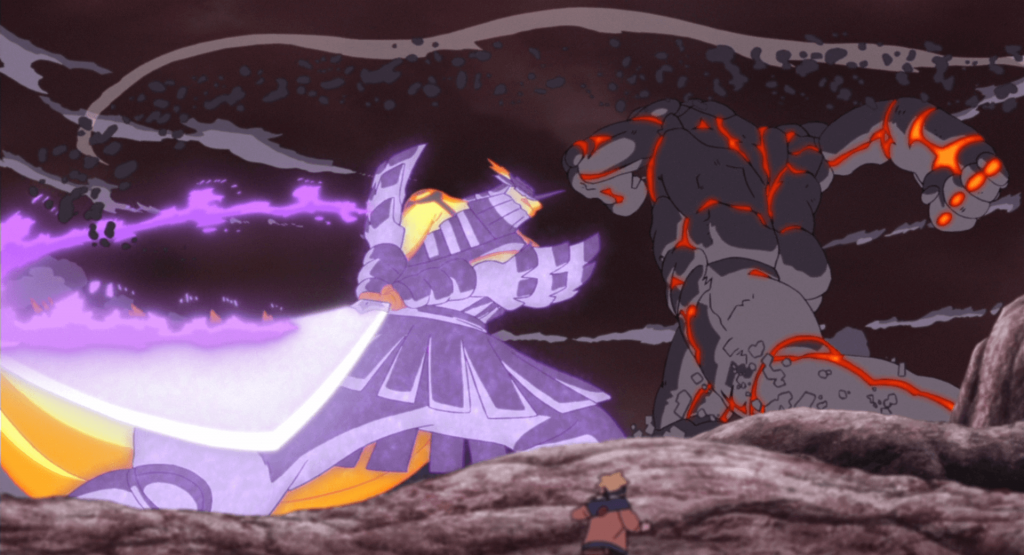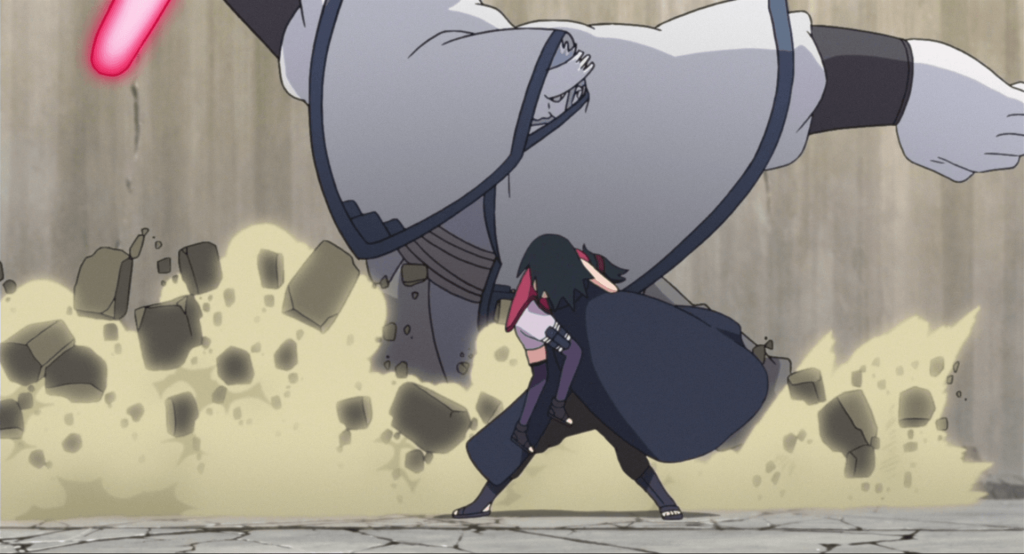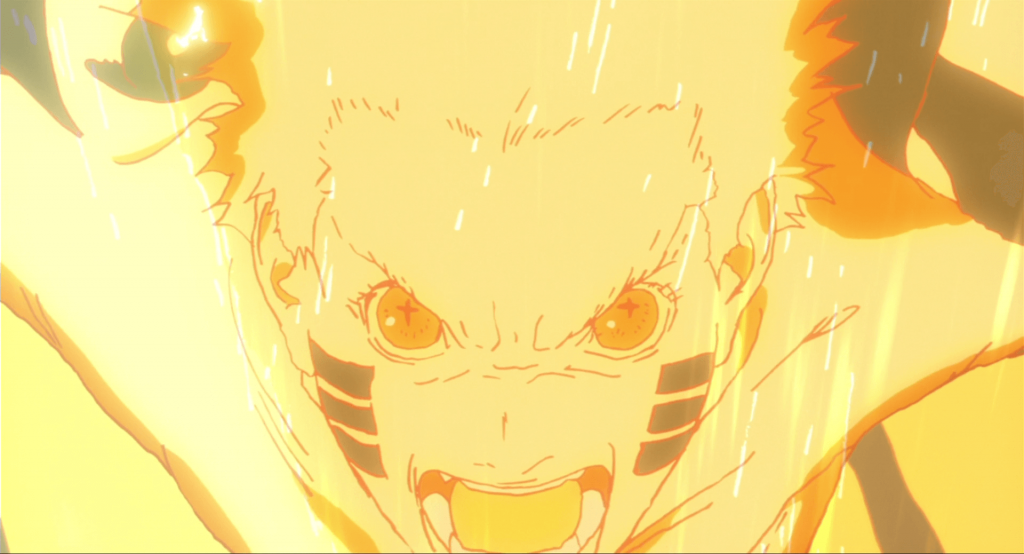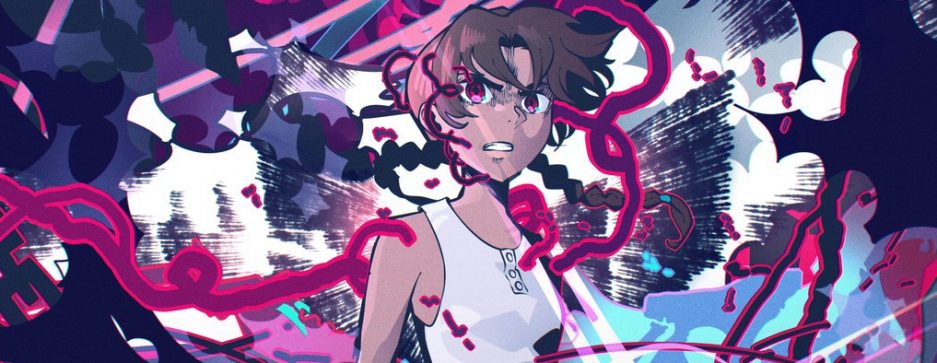
Part 1 | Part 2 | < > | Part 4 | Part 5
Kishimoto: After I finished watching The Last: Naruto the Movie [Jump Festa Event, December 2014], right when it had ended, I couldn’t believe they actually used the Boruto concept design I gave to the editor. And even put out the sentence “Airing in August”. It was at that time I suddenly panicked. Before I even got to appreciate how good The Last: Naruto the Movie was, the first thing that came to me was a feeling of danger. (laughs)
Yamashita: I even remember I blurted out to Kishimoto-sensei, “Next year Summer!?” (laughs)
The above excerpt stands as a sober reminder of the ever growing disconnect between anime producers and anime creators. It is no secret money and art struggle to co-exist, but even with that fact in hand, that the creator of the NARUTO franchise would be taken by surprise over the existence of this movie is difficult to fathom. While this issue is far from a new phenomenon, as a 2015 film, Boruto: Naruto the Movie was conceived around the start of an industry-wide shift; one which saw the worldwide simulcast market burst open the floodgates, leading to an overall surge in anime productions as a result. While this is certainly a topic large enough for its own piece, the point as it relates to Boruto: Naruto the Movie is that it received the short end of the stick when it comes to scheduling, and given recent trends, it’s not at all surprising.
There are other factors worth considering besides outright corporate greed though; in particular, the unfortunate timing of the manga ending one month prior to Jump Fiesta 2014, and on a note which includes Boruto’s generation in the final chapter no less. Considering that the average shelf life of media is forever decreasing under the sheer volume of new titles available to consumers, the time to capitalize on the “next generation” while it was still fresh in the minds of the readers would be as soon as possible.
Ultimately, the call to produce a film from scratch in a mere seven months would not only cost the TV anime dearly – subjugated to the famously dubbed ‘filler hell’ while nearly the entire staff was focused on the film – but moreover every production Pierrot was involved with at the time saw similar shortages of staff. Leading this massive team was of course Hiroyuki Yamashita, who, after initially turning it down because he felt he was not qualified, joked that he only got the job because nobody else wanted it. Regardless, as the director of this film, his perfectly linear rise is completed – from a douga artist, to key animator, to animation supervisor, followed by episode direction, and finally the director (kantoku) role. Few artists in this industry can boast such a feat, but then again, few artists are as exceptional as Hiroyuki Yamashita.



In its finished state, Boruto: Naruto the Movie is remarkably well animated – even without considering the inhumanly short time they had to produce it. NARUTO movies typically ran on a yearly cycle, with dedicated staff to ensure the process went smoothly. In comparison, the BORUTO movie script was finished at the end of January, meaning the staff at Studio Pierrot had effectively less than half a year at best to bring the story to life. For this reason it can be enticing to romanticize Hiroyuki Yamashita, and by extension, the efforts of everybody else creatively involved. Their ambition was at such a level where Tetsuya Nishio, upon looking at the storyboards, deemed them impossible to animate in the given time frame. And yet, they pulled it off and then some. This speaks to a reality where the production of Boruto: Naruto the Movie is instead a tale of passionate artists being exploited. For his ambition, Yamashita was hospitalized on more than one occasion during the films production. Meanwhile, one can only imagine the amount of unpaid overtime and sleepless nights that were experienced by the rest of the staff. All these problems are symptomatic of a broken anime-making system, and while this may be a particularly problematic case given the bar those individuals involved were trying to reach, it’s worth keeping in mind the larger picture.
That larger picture is one which sees Boruto: Naruto the Movie as a product rather than a creative venture from the perspective of those funding it. It is hard to argue these two sides can amicably co-exist when realistically, the production committee lead by Shueisha and TV Tokyo would have been satisfied with even a poorly made movie – look no further than the deadline they set for proof – so long as the next generation of shinobi made their appearance on the big screen. The fact that it’s anything better than that is owed entirely to the staff.
So far this piece almost exclusively paints the large corporations and those representing them in a poor light, and make no mistake, that is valid. However, there is another important aspect to this multifaceted issue which needs to be addressed, and that is that there are certain individuals who will willingly sacrifice their health and wellbeing in the pursuit of prestige and perfection. They do this regardless of external factors such as scheduling or personnel – which is to say, even with all the accommodations in the world, we may still find them with their backs against the wall at the 11th hour. Naturally, deadlines exist for this reason, and while Hiroyuki Yamashita may or may not be one such individual, the point is that the suits producing this film never gave us a chance to find out. Producers lose the right to place any blame on unreasonable creator ambitions when they never made an attempt to accommodate them in the first place.
In any event, Boruto: Naruto the Movie was a commercial success, especially relative to its pre-Kimetsu no Yaiba time period. The most successful Naruto film as of writing, it doubled up on the previous record earnings, landing at nearly 40 million USD worldwide. A major factor in its success can surely be attributed to Masashi Kishimoto’s involvement. For the previous ten franchise films, Kishimoto was too busy with NARUTO’s serialization in Shounen Jump to contribute anything other than his approval. It’s only with the conclusion of the manga (and the postponement of his honeymoon) that the man to whom this series owes everything was able to dedicate himself to a film script that, for the first time, carried genuine weight.
As a narrative work, Boruto: Naruto the Movie faced many challenges. Turning the page to a new generation is never easy, and doubly so when the old generation was still far from finished, with the manga only just concluding and the TV adaptation still hundreds of episodes from the end. The movie asked viewers to accept an entirely new perspective of the knuckleheaded ninja we came to love, with the core of the story hinging around Naruto’s neglectful fathering and the resulting resentment from his son.
It’s difficult to see a hero debased in such a shameful way, while at the same time, Boruto’s antagonistic attitude to his father (as well as his willingness to cheat), does him no favors in the eyes of the audience. This lose-lose dynamic is an incredibly difficult one to balance from a creators perspective, since without giving proper consideration to both sides, many fans would find themselves understandably frustrated with the set-up of the film. Masashi Kishimoto has said he based this dynamic around his personal life, with Naruto’s duties as Hokage being analogous to his career as a weekly mangaka. Personally, I hold Kishimoto’s work with this film in high regard, and despite some flaws, consider it to be one of his better writing moments. I appreciate how it avoids much of the generic character drama present in all other NARUTO movies, and instead uses the premise to fuel a heartfelt message about family ties spanning generations.
As far as Hiroyuki Yamashita’s involvement in the story goes, his knowledge of NARUTO’s cast played an instrumental role in hitting on the emotional beats of the movie, with Masashi Kishimoto himself having remarked the same. Several scenes come to mind, such as the one where Shikamaru informs Naruto that Boruto’s team advanced to the next round in the exams, to which Naruto initially responds stoically, only to revert back to his childish self once Shikamaru leaves the room. Or the scene where Hinata views the visual metaphor of Boruto and young Naruto, which was Yamashita’s original idea. Arguably the most touching scene of the movie can be found around the midway point, where for the first time we are granted a peek at proper child-like elation from Boruto after receiving encouraging words from his father.
On the topic of Tetsuya Nishio, he is in large part the reason much of anything seen in the film was even possible. As one of the most lucrative character designers in the industry, he rarely afforded hands-on time (which is to say animation work, rather than promotional art and designs) to the NARUTO franchise, preferring instead to attach himself to filmmakers such as Mamoru Oshii at Production I.G. In fact, The Last: Naruto the Movie (2014) marked his return to an animation supervisor role for the first time since Naruto the Movie: Legend of the Stone of Gelel (2005) – seven feature films prior!
With BORUTO having no-manga to speak of at this point, Tetsuya Nishio would have had much more control over the visual direction of the designs, and it shows in the end result. This change would also find its way into the television adaptation, and ultimately carry over into the Boruto: Naruto Next Generations TV series years later.
I mentioned earlier that this film’s production was an all-hands-on-deck affair, but in order to emphasize the extent to which it was, going through each faction of key animators present is a worthy exercise. Tetsuya Nishio brought a pair of Production I.G. veterans along in Kazuchika Kise and Shingo Takenaka, both masters of character acting and making their first contributions to the franchise. On the other end of the spectrum, we have the Studio Pierrot movie regulars tied to producer Shoji Matsui. Namely, the legendary effects animation trio of Hirofumi Masuda, Masaaki Endo, and Hidetsugu Ito. Shinji Hashimoto meanwhile has also been a sporadic regular to the NARUTO film scene, and his participation here is fortunate given the importance of the scene Yamashita trusted him with.
The next group, much to the chagrin of Tokyo Ghoul fans, came from producer Tetsufumi Hotta’s side, specifically consisting of Katsuya Yamada, Atsuki Shimizu, Narihito Sekikawa and Yuji Takagi. Tokyo Ghoul: Root A has numerous unrelated issues of the production and planning variety, so to accredit all of its shortcomings to the BORUTO movie’s unforeseen existence is unfair. With that said, many of its key staff participating here in large capacity (Atsuki Shimizu in particular did approximately 100 cuts of key animation!) could not have helped the sequel series’ cause.
For as impressive as the rest of the movie happens to be, it doesn’t truly cement itself as a feat of animation until its final act. In what must be a favor of a lifetime, Norio Matsumoto returned to the NARUTO franchise to aid his former student by supervising close to fifteen minutes of action at the climax of the film. Flanked by his personal crew of up-and-coming artists like Tatsuro Kawano, Hiromitsu Seki, Arifumi Imai and many more, this group put out some of their respective best work to date, along with the legendary Matsumoto who would make his presence felt across the entire span. Whether it be his easy flowing storyboarding, or charismatic corrections, few individuals have as grandiose a presence and fewer still are as humble about it.
Masashi Kishimoto left only one instruction for this part of the movie, with any and all remaining details up to the staff’s discretion: “Since this is the first time [Naruto and Sasuke] fight together, this scene must be made to excite people no matter what.”
The result speaks for itself.
The NARUTO series has always been among the best when it comes to sophisticated action, and with animators like Norio Matsumoto and Kenichi Fujisawa at your disposal, it’s easy to see why. Taijutsu was an intentional focus of the film and I appreciate how despite its close quarters nature, the sense of scale is still massive. To that end, the abundant background animation integrated throughout the action goes a long way in establishing the speed and space around which they’re fighting.
If the tight schedule was a burden on their work it certainly doesn’t show in the result, with the staff even sparing the time to have a little fun by sneaking Pakkun into the action for a couple frames (Yamashita only learned of their antics at the celebration dinner).
The aforementioned Arifumi Imai is also deserving of a closer look, as this was the platform to what is still widely considered some of his best work.
It is difficult to imagine a scene as titanic as this in any hands other than Arifumi Imai’s. His charismatic output has been largely defined by gargantuan creatures moving with likewise gargantuan weight. However, unlike his involvement with Attack on Titan which pits human against titan, this scene trades 3D maneuver gear for… another titan! He would animate both in mostly full animation, which is to say every frame is a unique drawing. The number of layers and amount of detail poured into his work is genuinely astounding.
To this point I have deliberately avoided mentioning Naoki Kobayashi. In the previous entry of this series, he was introduced as a key member of Hiroyuki Yamashita’s action allies. It’s no different here, as Yamashita would entrust the entire cold open of the film to his twenty-four year old protegee. Thus, the sequence between Sasuke and Kinshiki Ōtsutsuki is storyboarded, directed and animated by Naoki Kobayashi, making for one of the largest and most impressive jobs of his career to date.
For most people this alone would be considered a more than sufficient contribution, but Norio Matsumoto had other plans – personally requesting that Naoki Kobayashi handle the final rasengan (By this point the two had already become acquainted thanks to Yamashita acting as the liaison).
With this, the beginning and end of the sakuga showcase that is Boruto: Naruto the Movie is bookended by Naoki Kobayashi. He would even display seniority beyond his years with this last scene, suggesting in a production meeting that Boruto should receive some recoil damage to his arm from using the giant rasengan (He recalled the chapter where Naruto similarly received damaged after attacking Kabuto). Hiroyuki Yamashita listened with interest and in the end, decided to support Kobayashi’s idea.
Ultimately, despite the unfortunate conditions it was conceived under, the BORUTO movie can be considered a success. It moreover represents a turning point for the NARUTO franchise. In the visual sense, as Tetsuya Nishio’s updated movie designs replaced the inconsistent mosaic of episodic drawing styles the television series had operated under for years. While director of photography Mai Masuno would likewise maintain the same technologically savvy compositing style from the movie that was previously foreign to the series outside of particular director one-off appearances.
The success of the movie also spawned a monthly BORUTO manga – announced in May of the following year – which happened to be before the NARUTO manga had even finished being adapted. Shortly after, Boruto: Naruto Next Generations was decided and it’s director: Hiroyuki Yamashita.
However, before we can explore the ramifications of these franchise-altering decisions, there is one more event to cover: Naruto versus Sasuke, round 2.

One thought on “Animator Spotlight: Hiroyuki Yamashita & Boruto: Naruto the Movie (Part 3 of 5)”